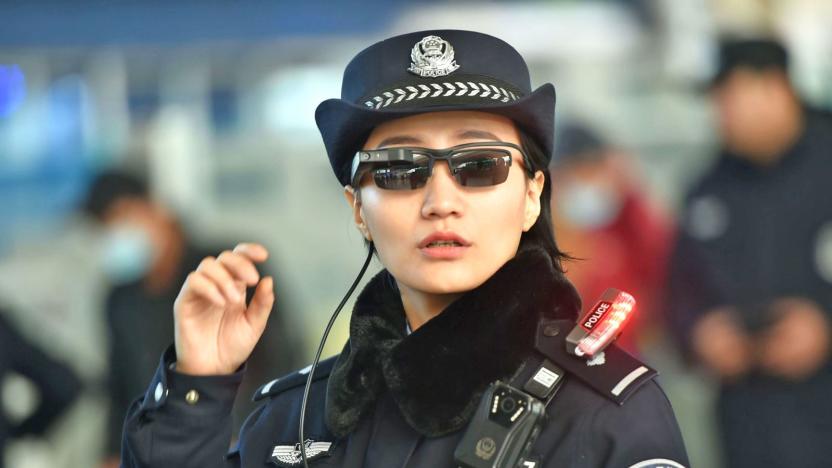FacialScanning
Latest

China’s law enforcement expands use of facial recognition glasses
Police in China are expanding their use of facial recognition glasses. Last month, law enforcement in the country used LLVision Technology's facial recognition glasses to spot criminals evading the law or train and plane passengers using fake IDs among the millions traveling for the lunar new year. Now, Reuters reports, police are using them to check travelers and car registration plates outside of Beijing ahead of Parliament's annual meeting in the city.

Your face could be your ticket to fly on JetBlue (updated)
Airports are where hopes and dreams go to die. But JetBlue thinks that one method of how people typically pass the time could be used to speed up the boarding process. For some passengers, a taken-at-the-gate photo will suffice to get them to their sky-chair. It's part of a collaboration between the airline and the US Customs and Border Protection (CBP) office, Jetblue announced today.

'NBA 2K15's' face scanning creates frightening players
NBA 2K15 arrived today, and with it comes a face-scanning feature that allows you to create a player based on your appearance. Well, as you might expect, the results when you don't sit still are... interesting. The folks over at SB Nation compiled a few of the most awesomely terrible creations, and they're quite scary. Of course, I'm interested to see what this means for the return of "NBA Y2K" in a few weeks. Looking to avoid transforming yourself into some sort of goblin? Here are a few tips for a proper scan. If only you could opt for EA's rig for a bit more accuracy.

Disney researchers can now digitally shave your face, clone it for animatronics (video)
The minds at Disney Research aren't only interested in tracking your face -- they want to map, shave and clone it, too. Through a pair of research projects, Walt's proteges have managed to create systems for not only mapping, digitally reconstructing and removing facial hair, but also for creating lifelike synthetic replicas of human faces for use in animatronics. Let's start with the beards, shall we? Facial hair is a big part of a person's physical identity, a quick shave can render a close friend unrecognizable -- but modern face-capture systems aren't really optimized for the stuff. Disney researchers attempted to address that issue by creating an algorithm that detects facial hair, reconstructs it in 3D and uses the information it gathers to suss out the shape of the skin underneath it. This produces a reconstruction of not only the skin episurface, but also of the subject's individual hairs, meaning the final product can be viewed with or without a clean shave. Another Disney team is also taking a careful look at the human face, but is working on more tangible reconstructions -- specifically for use on audio-animatronic robots. The team behind the Physical Face Cloning project hope to automate part of creating animatronics to speed up the task of replicating a human face for future Disney robots. This complicated process involves capturing a subjects face under a variety of conditions and using that data to optimize a composition of synthetic skin to best match the original. Fully bearded animatronic clones are still a ways off, of course, but isn't it comforting to know that Disney could one day replace you accurately replicate your visage in Walt Disney World for posterity? Dive into the specifics of the research at the source links below, or read on for a video summary of the basics.

Researchers demo 3D face scanning breakthroughs at SIGGRAPH, Kinect crowd squarely targeted
Lookin' to get your Grown Nerd on? Look no further. We just sat through 1.5 hours of high-brow technobabble here at SIGGRAPH 2011, where a gaggle of gurus with IQs far, far higher than ours explained in detail what the future of 3D face scanning would hold. Scientists from ETH Zürich, Texas A&M, Technion-Israel Institute of Technology, Carnegie Mellon University as well as a variety of folks from Microsoft Research and Disney Research labs were on hand, with each subset revealing a slightly different technique to solving an all-too-similar problem: painfully accurate 3D face tracking. Haoda Huang et al. revealed a highly technical new method that involved the combination of marker-based motion capture with 3D scanning in an effort to overcome drift, while Thabo Beeler et al. took a drastically different approach. Those folks relied on a markerless system that used a well-lit, multi-camera system to overcome occlusion, with anchor frames acting as staples in the success of its capture abilities. J. Rafael Tena et al. developed "a method that not only translates the motions of actors into a three-dimensional face model, but also subdivides it into facial regions that enable animators to intuitively create the poses they need." Naturally, this one's most useful for animators and designers, but the first system detailed is obviously gunning to work on lower-cost devices -- Microsoft's Kinect was specifically mentioned, and it doesn't take a seasoned imagination to see how in-home facial scanning could lead to far more interactive games and augmented reality sessions. The full shebang can be grokked by diving into the links below, but we'd advise you to set aside a few hours (and rest up beforehand). %Gallery-130390%




